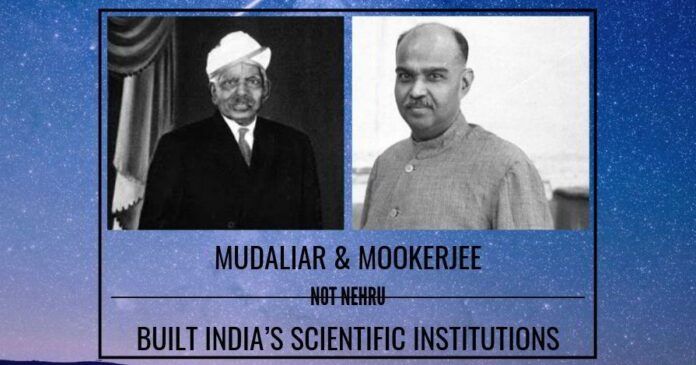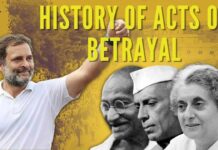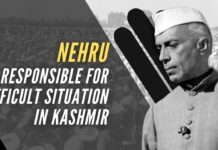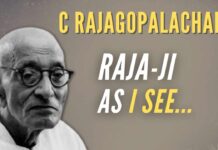
It is worthwhile to reflect on the immense damage to India inflicted by Nehruvian Sovietism.
Indira Gandhi, echoing the ideas of others who had made similar statements, once said, “There are two kinds of people, those who do the work, and those who take the credit.” She must have observed this first hand from close quarters as some of her family members have taken credit for the work of others.
According to Jawaharlal Nehru and his hagiographers like Shashi Tharoor, it was Nehru who came up with the idea of introducing science in India and was the force behind the creation of India’s scientific establishments. This claim has been converted into “truth” by relentlessly repeating it so many times that students of propaganda around the world could use it as a case study to learn how to effectively manufacture and spread their own “truths”. Tharoor, whose political career hinges on pleasing the Nehru family, understandably lays it a bit thick when he credits Nehru for 40% of Silicon Valley’s startups.
The founding of the Indian Institutes of Technology and the All India Institute of Medical Sciences too had nothing to do with Jawaharlal Nehru.
In reality, it was through the vision and effort of Arcot Ramaswami Mudaliar that the Council of Scientific and Industrial Research came into existence in 1940 and it was Dr Syama Prasad Mookerjee who built it up. Nehru had no part to play in it and his name got attached to CSIR as the nominal president by virtue of him becoming the Prime Minister of India. During this period, Nehru explained his lack of contribution: “The members of the governing body will appreciate that it is difficult for me to devote much time to many aspects of the work of the Council… For the present, Dr Syama Prasad Mookerjee will, however, look after the day-to-day routine work of the Council.”
A number of laboratories were set up by Dr Mookerjee, including the National Physical Laboratory, National Chemical Laboratory, National Metallurgical Laboratory, Fuel Research Institute, Ceramics Research Institute, Central Leather Research Institute, and the Central Electro Chemical Research Institute. It was during Dr Mookerjee’s tenure that plans had also been made for the integration of Pykara, Mettur, Shimoga and Sivasamudram as one electrical grid.
By the 1940s, India already had the infrastructure for supporting scientific activities and India’s Hindu civilisation had generated many scientific ideas and scientists over thousands of years. Institutes like the Banaras Hindu University which was founded by Pandit Madan Mohan Malaviya, the Indian Institute of Science, the Indian Association for the Cultivation of Science which had been founded in 1876, the core of Indian Statistical Institute, and the Tata Institute of Fundamental Research, all pre-dated Nehru’s time in office, but Nehru and his supporters have taken credit for the creation of these establishments. Among the public sector units, Hindustan Aeronautics Limited had been set up by Walchand Hirachand as a private business and it supplied state-of-the-art aircraft to Britain for its war efforts, but it rapidly deteriorated after the Nehru government started managing it.
The founding of the Indian Institutes of Technology and the All India Institute of Medical Sciences too had nothing to do with Jawaharlal Nehru. While the IITs had their genesis in N.M. Sircar Committee report of 1945, Nehru’s indifference towards setting up medical institutes were captured in an exchange between Dr Mookerjee and N.G. Ranga in the Constituent Assembly. When Dr Mookerjee mentioned that a committee under the chairmanship of Dr Arcot Lakshmanaswami Mudaliar had been set up to establish an All India Medical Institute, N.G. Ranga highlighted Nehru’s statement opposing the All India Medical Institute in Delhi on the grounds that the housing problem had to be solved first.
Priyanka Vadra was also quick to give credit to her great grandfather Nehru when India tested an anti-satellite missile. This was despite the fact that neither DRDO nor ISRO resulted from Nehru’s ideas or efforts.
This was of course standard rhetoric on the part of Nehru. His pro-Soviet leanings came to the fore time and again, including in the infamous Avadi Resolution of the Indian National Congress calling for the imposition of the “socialistic pattern of society” on India and the Second Five Year Plan, which focused on his effort to transform India into a communist economy on the lines of the Soviet Union. According to this plan, production in both the agricultural and manufacturing sectors would be converted into large-scale factories under the monopolistic control of the government, and the entire population would be dehumanised and converted into cogs in the wheels of the massive government machinery, with the workers given just enough to lead subsistence lifestyles. A chosen few including Nehru himself, his family members, and his friends would be declared intellectuals and thinkers, and they would be the only ones who led lives of luxury, occupied top government positions, and controlled the resources of the country. They would also be awarded titles and honorary degrees in the same way that members of the class which came to be known as the “nomenklatura” in the Soviet Union were awarded titles, while the rest of the population would appreciate and applaud them, and even hero-worship them and their statues placed strategically around the country.
It was this flawed vision which made Nehru indifferent to the All India Council of Technical Education’s recommendation to set up management institutes, and instead go ahead with his effort of creating Joint Management Councils in industries. Such councils would supposedly end the “social contradiction” of authoritarianism at the workplace and democracy in society and usher in an era of “industrial democracy”. Parallel efforts in the agricultural sector resulted in Nehru attempting to impose the method of Soviet-style collective farming on the country. Needless to say, both these policies ended with disastrous results and can be blamed for many starvation deaths in the country.
Nehru’s apathy towards science and his support for “socialist” pseudoscience is best illustrated by his treatment of Srinivasa Sourirajan and other scientists. Nehru propped up his supporters and made them the key people, who ended up influencing the Indian scientific institutions over the next few decades. Soon, there were complaints of a class of “science bourgeoisie” who were oppressive and squelched talent, resulting in an exodus of scientists leaving India, a problem that came to be labelled “brain drain”.
One such scientist who left India after completing his doctorate degree and teaching for a brief period was Srinivasa Sourirajan. In 1958, not long after he reached the United States, he created the world’s first membrane capable of desalinating seawater through the process of reverse osmosis. He then admitted Sidney Loeb as a partner in his project, and together, they patented the commercial version of this membrane. It is this technology that has quenched the thirst of millions of people in many countries including Israel and Saudi Arabia. While Israel has celebrated Sidney Loeb and has invested in the membrane, the Nehruvian establishment ensured that no one in India would hear of Sourirajan or his technology. Last heard of, Sourirajan was at a very advanced age living in Canada, and scientists in the area of membrane technology had nominated him for the highest honours in the world. The least India could do is to award him a Bharat Ratna and seriously look into implementing his technology to solve India’s water shortage and also ensure that the project is not named after Jawaharlal Nehru.
Taking credit for the work of others continues to this day by admirers of the Nehru family. Hearing them say it, one would be led to believe that Rajiv Gandhi and Sam Pitroda were responsible for the telecom revolution in India due to the technology they created. In reality, Pitroda failed to deliver on his indigenously built telephone exchange for which the government had given him a huge amount of money, and he ended up being investigated by the Nambiar Committee and also faced allegations of financial irregularities.
Recently, Priyanka Vadra was also quick to give credit to her great grandfather Nehru when India tested an anti-satellite missile. This was despite the fact that neither DRDO nor ISRO resulted from Nehru’s ideas or efforts. While DRDO was set up by grandfathering in two units of the military that had existed since the 1920s, the rocket launching facility at Thumba was born out of the insecurity of Western nations that lagged behind the Soviet Union in space technology. They used the United Nations to insist that space research be a collaborative effort which included all countries in the world and India benefited from this program when Thumba was chosen as the site of an international facility for launching sounding rockets.
Nehru’s various follies in the arena of foreign policy such as taking Kashmir to the United Nations, turning down the Security Council seat and instead lobbying for China to be made a Security Council member, and losing a war to China through mismanagement are too well known.
Nehru also opposed acquiring missiles and the atom bomb and stated, “The distribution of this toy—the atom bomb, ballistic missiles and the like to other countries will not only be dangerous, very dangerous, but it will completely poison the already disturbed atmosphere of the world today.” He termed making the atom bomb “dangerous and dreadful” and was the first person to advocate the racist policy of excluding India and other Asian countries from the nuclear club—a policy that would later be written into the Nuclear Non-Proliferation Treaty that India would spend decades fighting—when he claimed that “the going of this atomic weapon into an Asian country would be a dreadful thing, a very dangerous thing”.
While the Nehru flatterers constantly came up with excuses for the poor infrastructure in India, be it roads, the transport system, or basic amenities such as sanitation and the garbage disposal system, two non-Nehruvian governments between them built 55 flyovers in Mumbai to ease the traffic congestion, came up with a modern commuter rail system in Delhi which other cities have sought to replicate, built the Golden Quadrilateral, opened up the internet to the common people, brought cooking gas to poor people, and built toilets for those without access to them.
Nehru has also taken credit for unification of India and the democratic values of Indian people even though Sardar Patel had to trick him and send the Army into Hyderabad, and Nehru’s contributions to democracy have been India’s First Amendment, which abridges the free speech rights of Indians and the use of Article 356 to dismiss the state governments of political opponents. Nehru’s various follies in the arena of foreign policy such as taking Kashmir to the United Nations, turning down the Security Council seat and instead lobbying for China to be made a Security Council member, and losing a war to China through mismanagement are too well known and need not be elaborated here. Among other dubious distinctions of Nehru are nepotism in the form of giving a plush ambassadorship to his sister and the Congress presidency to his daughter, overseeing the first corruption scandal in India, overseeing the first case of booth capturing, and indulging in self-aggrandizement.
In closing, it is worthwhile to reflect on the immense damage to India inflicted by Nehruvian Sovietism. Keep in mind the description of the state of India by the parliamentarian Dr B.N. Singh just three months before the death of Nehru, “If you take a glimpse of rural India, you will see a more ghastly spectacle-indescribable poverty and misery in every village, a daily income of between 19 and 31 Rs for over half of the population; population increase outstripping national income growth, illiteracy still between 70 to 80 per cent, caste’s apartheid spreading within society like a fungus disease, an epidemic here and a famine there, corruption in the police, graft in Government, cynicism and patronage in higher politics, bullying and intimidation in lower, gloom and frustration written large on the face of the people.”
Note:
1. Text in Blue points to additional data on the topic.
2. The views expressed here are those of the author and do not necessarily represent or reflect the views of PGurus.
Republished with the permission of The Sunday Guardian
- Wanted: An Indian Uncle Tom to work for New York Times - July 9, 2021
- Anti-Hindu USCIRF: Sex, Crime, Bigotry In The Name Of Religious Freedom - January 2, 2020
- Mudaliar, Mookerjee, not Nehru, built India’s scientific institutions - May 3, 2019











Slogan was “after Nehru Who”? Cartoonist answer was the “deluge”!!
Soon after the death of Indira and Rajiv so many institutions and infra projects were named after them only! All developed colonies were named after Nehru and slums after Mahatma Gandhi!! Dr.Ambedkar et al were forgotten!!!
Well who forgets pre–independence era ” Brits Legacy” of buildings/mansions, four international airports, few sea ports, Kurnool Cuddapah canal, 30000 railway lines, exploitations, paid informers and may be many more……….
At the time of independence 30 crores was our population. Nehru nominated himself as Bharat Ratna by himself before his death. Nehru Kurta and jubba was popularized as if others walked and lived naked! How many nobel prizes Indians won staying within the country then or won after leaving the Indian shores, huge brain drain, and few scientists suspected deaths in plane crashes, certain politicians’ deaths abroad or within the country are debatable?
With regard to how much publication our scientists published in foreign mags without plagiarism? Are our scientific institutions world class? Why ISRO,DOS, DRDO,DRDL, DMRL is dominated by only people from few states?
One draws inspiration from our scientist’s achievements unfortunately not named after them and lack of lessons in schools on our ancestor’s scientific tempers, temples scientific architectures were relegated to the background by the Nehru-Gandhi’s adopting foreign economic models, Macaulay educational system, historians depicting invaders as builders, importing foreign thoughts and lifestyles killed the very Sanatana Dharma linked with Truthfulness.
When we were kids, we used to hear how Nehru used to get new clothes from Swiss, Curds from England…………….and he cremated his wife in Switzerland, he’s a womanizer /last Englishman may not matter much now but fact remains that Health and Hygiene, 75% poverty, illiteracy, famines, lack of good infra, committed judiciary, neglected agriculture, family rule, lack of strong opposition parties did damage our country in so many ways up to 1990. Patriotism develops on every 26th Jan and 15th Aug.
Question of aligning with a strong or a weak nation based on ideology or scientific temper depends on the Head of the State.
If at least government of the day allocates 6 percent out of the total Budget towards education and higher scientific institutions our nation may be on par with G20.
India should not become a graveyard of western obsolete, second hand junk technologies but move towards Green Technologies.
Arvind Kumar, I must say this article is in very bad taste. In the first place, the very idea of trying to judge yesterday’s leaders with today’s lens is bad form. Furthermore, you failed to restrict yourself to scientific institutions. Anyway.
Nehru passed away in May 1964. Can you name a scientific institute that was formed after his demise? When was the next IIT?
As the head of the state he does deserve credit for the organizations that were formed during his time. You cannot take that away from him.
Finally, about the Russian or the socialist influence. The present government displays a similar US influence. Their wanton destruction of environment for the unbridled development could turn out to be a bad choice.
I didn’t expect such a biased narrative from you, sir!